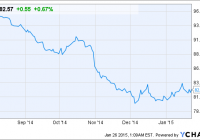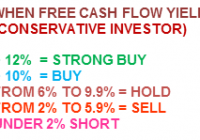A Low-Tech Index Offering Exposure To The High-Tech Sector
By Robert Goldsborough Investors craving a big helping of large-cap growth stocks with a strong tilt toward the technology sector can consider PowerShares QQQ ETF (NASDAQ: QQQ ) . A perennial favorite among U.S. large-cap growth investors, QQQ is the sixth most actively traded U.S. exchange-traded fund and has the sixth-most assets of any U.S. ETF. QQQ also offers exposure to leading Nasdaq-listed consumer discretionary firms (18% of assets) and biotech firms (15% of assets) and tracks the cap-weighted Nasdaq-100 Index, which includes the 100 largest nonfinancial stocks in the Nasdaq Composite Index. Given its narrow sector focus, this ETF would work best as a satellite holding in a diversified portfolio. This is a high-quality portfolio with a mega-cap tilt, with more than 87% of assets invested in large-cap companies and more than 93% of assets invested in companies with Morningstar Economic Moat Ratings, those that Morningstar’s equity analysts deem as having sustainable competitive advantages. However, given this fund’s sector tilts, it is more volatile than a broad portfolio of large-cap stocks. For example, over the past 10 years, it has had a volatility of return of 18.0% compared with 14.6% for the S&P 500. When considering whether to invest, investors should take note of the fact that stocks in this fund make up almost the entire 20% tech component of the S&P 500. Despite the relatively low overlap, QQQ has a high correlation in performance with the S&P 500 (90% over the past 10 years) and an even higher correlation with the large technology ETF Technology Select Sector SPDR (NYSEARCA: XLK ) (98% over the past 10 years). Fundamental View The U.S. technology sector dominates QQQ and accounts for fully 58% of its assets, and large-cap tech firms’ performance determines its fortunes. The single largest dynamic affecting the tech sector right now is the shift to mobile computing and growth in cloud computing. Mobile and cloud computing are truly disruptive forces in the tech sector. As users shift to mobile devices, PC sales continue to fall. Global PC shipments dropped by 10% in 2013 and were flat to slightly down in 2014, with developed markets stabilizing but emerging markets seeing declines, as users shift to tablets. Despite sluggishness in PC sales, the total number of devices sold is expected to rise meaningfully in the years to come, as consumers and businesses adapt to smartphones and tablets. Our analysts project that some 2.6 billion-plus computing devices will ship in 2017–more than twice the total number of devices that shipped in 2012. Across the tech sector, firms are reshaping their portfolios for this ongoing transition. Microsoft (NASDAQ: MSFT ) in 2013 acquired Nokia’s (NYSE: NOK ) handset business and has developed the Windows Phone operating system, while Intel (NASDAQ: INTC ) has invested heavily in producing microprocessors optimized for mobile devices. Apple (NASDAQ: AAPL ) leads the marketplace with its iPhone and iPad, continually gaining share from struggling competitors. And Google (NASDAQ: GOOG ) (NASDAQ: GOOGL ) long has had a dominant position in Internet search and has aggressively invested in its Android operating system for smartphones and tablets, providing it free of any license fees. Having Google software on the device helps to ensure that when users search, they use Google. Enterprise hardware suppliers also are reshaping their businesses. Broadly, we are confident in tech firms’ positioning for growth in the medium term. Tech firms generally are procyclical in their performance, and with continued economic strength, tech firms generally should do well. The Gartner Group estimates that tech spending grew 3.2% in 2014, measured in constant currency, to $3.8 trillion and forecasts a growth rate of 3.2% in 2015. As large tech firms manage and reshape their businesses to adapt to secular declines in PC demand, we expect that they will continue to find ways to benefit from smartphone and tablet growth. To be sure, not all technology players will win in a world dominated by mobile computing and cloud computing. For instance, we view cloud computing as a moderate threat to all IT infrastructure suppliers, as cloud service providers are technically savvy customers. So as enterprises migrate their infrastructure to these service providers, infrastructure suppliers’ pricing power likely will decrease. Apple makes up 13% of the assets of QQQ and is far and away this ETF’s largest holding. Apple surged in 2014 after a turbulent 2013. The company benefited from strong earnings reports and guidance that beat expectations, driven by solid iPhone unit sales in both developed markets and in China. Although iPad sales have continued to lag, investors have been enthused by the launches of two larger-screen iPhones, Apple Pay, and Apple Watch and what it means for Apple’s continued ability to innovate. We expect Apple to remain a leader in the premium smartphone and tablet markets for years to come. Portfolio Construction Known as the Cubes or the Qubes, this ETF tracks the Nasdaq-100 Index, which was created in 1985 to represent the Nasdaq Composite Index’s 100 largest nonfinancial stocks by market capitalization. The top 10 holdings account for a significant 47% of the portfolio. While Apple has a narrow moat, this ETF’s next-largest eight holdings all have wide moats. The average market cap of this fund’s holdings is about $96.6 billion. The Nasdaq-100 index rebalances once a year, although it has on occasion conducted special index rebalances in order to prevent any one company from having an outsize impact on the index (the index caps any one company’s weighting at 24%). The last special index rebalance took place in 2011 and was driven by the continued overweighting of Apple. Fees This ETF is relatively inexpensive, with an annual expense ratio of 0.20%. Its estimated holding cost is slightly higher, at 0.25%. Estimated holding costs are primarily composed of the expense ratio but also include transaction costs, sampling error, and share-lending revenue. One alternative is Fidelity Nasdaq Composite (NASDAQ: ONEQ ) , which tracks the broader Nasdaq Composite Index. ONEQ contains 1,920 stocks listed on the Nasdaq, making it a much broader portfolio than QQQ’s. Given its broader holdings, ONEQ is less top-heavy, with the top-10 names accounting for about 31.5% of total assets. ONEQ also includes Nasdaq-listed financial stocks, which make up about 6.5% of its portfolio. The average market cap of ONEQ’s holdings (about $31.5 billion) is considerably less than that of the holdings in the Cubes (about $97.0 billion). This can be attributed in part to ONEQ’s 17% exposure to small-cap stocks. ONEQ charges 0.21%, with an estimated holding cost of 0.12%. A cheaper and less volatile large-cap growth fund is Vanguard Growth ETF (NYSEARCA: VUG ) , which has an expense ratio of 0.09%. The performance of QQQ is highly correlated with the performance of VUG (96% over the past five years). Similarly, another large-growth option is iShares Russell 1000 Growth (NYSEARCA: IWF ) , which charges 0.20%. With just more than one third the holdings of ONEQ, IWF is more concentrated than the Fidelity offering. At the same time, it’s far more diverse than QQQ. Even so, QQQ’s performance is highly correlated with the performance of IWF (96% over the past five years). Those seeking more-concentrated exposure to tech names can consider Technology Select Sector SPDR ( XLK ) , which carries a 0.16% expense ratio and holds 71 companies, all of which are information technology and related services, software, telecommunications equipment and services, Internet, and semiconductors. A less-liquid alternative is Vanguard Information Technology ETF (NYSEARCA: VGT ) , which holds 393 companies and charges just 0.12%. Disclosure: Morningstar, Inc. licenses its indexes to institutions for a variety of reasons, including the creation of investment products and the benchmarking of existing products. When licensing indexes for the creation or benchmarking of investment products, Morningstar receives fees that are mainly based on fund assets under management. As of Sept. 30, 2012, AlphaPro Management, BlackRock Asset Management, First Asset, First Trust, Invesco, Merrill Lynch, Northern Trust, Nuveen, and Van Eck license one or more Morningstar indexes for this purpose. These investment products are not sponsored, issued, marketed, or sold by Morningstar. Morningstar does not make any representation regarding the advisability of investing in any investment product based on or benchmarked against a Morningstar index.

